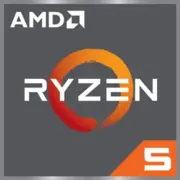AMD Ryzen 5 4500

AMD Ryzen 5 4500: Comprehensive Review of a Processor for Budget Builds in 2025
(Relevant as of April 2025)
Key Features: Zen 2 Architecture and Performance Balance
The AMD Ryzen 5 4500, released in 2022, remains a popular choice for budget PCs due to its favorable combination of price and capabilities.
- Architecture and Manufacturing Process:
Built on the Zen 2 microarchitecture, manufactured using TSMC's 7nm FinFET process. This ensures low power consumption (TDP 65W) and a solid thermal profile.
- Cores and Threads:
6 cores and 12 threads — optimal for multitasking and moderate workloads.
- Cache and Frequency:
8 MB L3 cache, base frequency of 3.6 GHz, and a maximum boost of up to 4.1 GHz in turbo mode.
- Key Features:
Support for PCIe 3.0 (instead of PCIe 4.0/5.0 found in newer models), Simultaneous Multithreading (SMT), and lack of integrated graphics (requires a discrete graphics card).
Performance:
In Geekbench 6 tests, the processor scores 1555 points in single-core and 6200 in multi-core modes. This level is sufficient for modern gaming at medium settings (e.g., Cyberpunk 2077 or Elden Ring at Full HD) and for photo/video editing in software like Adobe Premiere.
Compatible Motherboards: AM4 Socket and Chipset Selection
The Ryzen 5 4500 uses the AM4 socket, allowing it to be installed on many motherboards released since 2017. However, it's important to consider the BIOS version.
- Recommended Chipsets:
- B550: Optimal for most users — supports overclocking, PCIe 4.0 (for SSDs or graphics cards, although the processor itself is limited to PCIe 3.0). Example: MSI B550 Tomahawk ($120-150).
- A520: Budget option without overclocking. Suitable for office PCs (e.g., Gigabyte A520M DS3H, $70-90).
- X570: For enthusiasts, but excessive for the Ryzen 5 4500 due to cost ($150-200).
Selection Tips:
- Ensure that the motherboard has an updated BIOS (AGESA version 1.2.0.7 or newer).
- For upgrading older systems (e.g., from Ryzen 3 2200G), a BIOS flash may be required.
Supported Memory: DDR4 and Configuration Nuances
The processor only works with DDR4, which makes it less relevant for new builds on DDR5 in 2025, but advantageous for upgrades.
- Recommendations:
- Optimal frequency: 3200-3600 MHz (2×8 GB kits will cost $50-70).
- Dual-Channel mode is mandatory to unlock the potential.
- Latency (CL): Preferably CL16 or lower.
Example: A Corsair Vengeance LPX 16 GB (3200 MHz, CL16) kit for $55 demonstrates stable performance paired with the Ryzen 5 4500.
Power Supply: Minimum Requirements and Recommendations
With a TDP of 65W, the processor does not require a powerful PSU, but graphics card power consumption should be considered.
- Power Calculation:
- For a system with a graphics card like the NVIDIA RTX 3060 (170W), a 500-550W PSU is sufficient (e.g., EVGA 550 B5, $60-80).
- Integrated solutions (if using an external GPU) can cost about 400-450W.
Tip: Choose a PSU with an 80+ Bronze certification or higher — this ensures stability and longevity (Corsair CX550M, $65).
Pros and Cons: Who Should Consider This?
Pros:
- Energy efficiency: Ideal for compact builds (Mini-ITX).
- Price: In 2025, the new processor costs $110-130, cheaper than the Ryzen 5 5600 ($150-170).
- Multi-threading: 12 threads handle rendering and streaming well.
Cons:
- No PCIe 4.0: SSDs and graphics cards with PCIe 4.0 won’t unleash their potential.
- Outdated architecture: Lags behind the Ryzen 5 7500 (Zen 4) by 25-30% in single-threaded performance.
Use Case Scenarios: Gaming, Work, and Multimedia
- Gaming:
Pairing with an RTX 3060 or AMD RX 6600 guarantees 60+ FPS in Full HD (e.g., Call of Duty: Warzone on high settings).
- Work Tasks:
Editing in Photoshop, Blender (Cycles), code compilation — the processor manages, but for heavy scenes, the Ryzen 7 is preferable.
- Multimedia:
Streaming in OBS with GPU encoding operates lag-free.
Real Example: A build with Ryzen 5 4500, RX 6600, 16 GB DDR4, and 1 TB NVMe SSD costs $600-700, which is twice as cheap as high-end systems.
Comparison with Competitors: Intel and AMD
- Intel Core i5-12400F ($140-160):
Better in single-threaded tasks (Geekbench 6 Single Core ~1800), but more expensive. Choice depends on motherboard prices (LGA 1700 is pricier than AM4).
- AMD Ryzen 5 5500 ($130-140):
Close in price but has PCIe 4.0 and slightly better performance (+10% in games).
- Intel Core i3-13100F ($100-120):
Cheaper, but only 4 cores — weaker in multi-threading.
Conclusion: The Ryzen 5 4500 outperforms competitors in the budget segment due to its balance of cores and price.
Practical Assembly Tips
1. Motherboard: Choose B550 if you plan to upgrade to Ryzen 5000/5800X3D in the future.
2. Cooling: The stock cooler is sufficient, but for quieter operation, consider DeepCool GAMMAXX 400 ($25).
3. Case: Ensure good ventilation (example: NZXT H510 Flow, $80).
4. Graphics Card: Do not exceed RTX 4060/RX 7600 level to avoid bottlenecking.
Final Conclusion: Who is the Ryzen 5 4500 Suitable For in 2025?
This processor is the ideal choice for:
- Budget Gaming PCs: When savings are needed without significant FPS losses.
- Upgrading Old Systems: AM4 motherboard owners can upgrade by purchasing only the CPU and memory.
- Office and Multimedia Tasks: Speed in browsing, office applications, and 4K video work.
Why Choose It? For $110-130, you get 6 cores, low power consumption, and compatibility with many components. In 2025, the Ryzen 5 4500 is a sensible compromise between price and performance for those not chasing ultra-new releases.
Basic
CPU Specifications
Memory Specifications
GPU Specifications
Miscellaneous
Benchmarks
Compared to Other CPU
Related CPU Comparisons
Share in social media
Or Link To Us
<a href="https://cputronic.com/en/cpu/amd-ryzen-5-4500" target="_blank">AMD Ryzen 5 4500</a>
